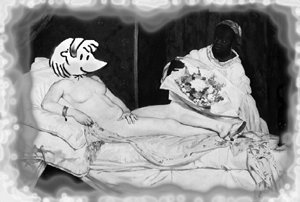Module 04: L’identité
In this section:
- les couleurs et les adjectifs
- Les articles définis
- le portrait physique – avoir
- les pronoms non-binaires
les couleurs et les adjectifs – colors and adjectives

| les couleurs (f)
blanc / blanche bleu / bleue gris / grise jaune marron (invariable) noir / noire orange (invariable) rouge vert / verte violet / violette |
colors
white blue gray yellow brown black orange red green purple |
Les articles définis – Definite articles

The definite article (le, la, l’, les) is often used with parts of the body instead of a possessive determiner (mon, ma, mes, etc.). Sentences with this structure always use the verb avoir to indicate that the possessor is the subject of the sentence. The following French sentences are equivalent.
![]()

|
![]()
However, an indefinite article is used if an adjective comes before the part of the body:
![]()
|
![]()
The definite article is also always used when pronominal verbs refer to parts of the body.
le portrait physique – avoir – to have
In French, there are two main verbs used to describe someone’s physical attributes. You may use “être” – to be – to describe how they are, or use the verb avoir – to have – to describe certain features.
Elle est blonde – using “être”. Notice the adjective “blond” agrees with the person’s gender here.
or
Elle a les cheveux blonds – using “avoir”. The adjective “blond” agrees with the noun it’s describing – cheveux (hairs) are plural and masculin.
J‘ai – I have
Tu as– you have
Il / elle /on a – he/she/they/one has
nous avons – we have
vous avez – you (all) have
ils / elles ont – they have
non-binary options: adjectives
The following suggestions for how to describe non-binary people is adapted from Julia Spiegelman’s “Student Guide to Non-Binary French”:
As mentioned in previous modules, the middot (point médian) can be used in inclusive written French to suggest gender neutrality: for example, les étudiant·e·s can include students of all genders.
Nouns: How to call people
Nouns that carry a gender unrelated to the person they designate:
- la personne – the person
- l’individu – the individual
- le personnage – the character
Nouns that stay the same regardless of gender (note: you may use either feminine or masculine article with):
- ado – teenager
- jeune – young person
- enfant – child
- élève – student
- adulte – adult
- partenaire – (work) partner
- collègue – colleague
- athlète – athlete
- touriste – tourist
Adjectives: How to describe people
Here are some adjectives that don’t change based on gender due to the fact that the base form already ends in an “e”, therefore no additional “e” is added to feminize it.
- adorable – adorable
- agréable – pleasant
- aimable – likable
- calme – calm
- désagréable – unpleasant
- dynamique – dynamic
- énergique – energetic
- lunatique – moody
- pauvre – poor
- riche – rich
- sage – wise, well-behaved
- sympathique/sympa – nice
- timide – shy
Punctuated forms using the middot (point médian), dash, or period are often used in inclusive written French to suggest gender neutrality: for example, les étudiant·e·s can include students of all genders. These forms are widely understood. This is the most standardized format to express inclusivity.
- Example: Sam est fatigué·e / fatigué.e / fatigué-e.


